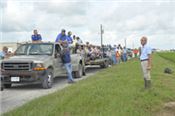|
Rice Farmers Should Scout Fields Amid Rainy Summer Weather

Steve Linscombe, LSU AgCenter rice breeder and director of the Rice Research Station, right,
speaks to farmers attending a field day at the LSU AgCenter H. Rouse Caffey Rice Research Station
South Farm in Crowley.
Photo by Olivia McClure/LSU AgCenter
CROWLEY, LA.
Recent wet weather has been conducive to disease problems in Louisiana rice, and frequent rains are hampering plants’ recovery from issues that normally are not considered serious.
Farmers heard the news at a field day held at the LSU AgCenter H. Rouse Caffey Rice Research Station South Farm in Crowley.
Sheath blight, a disease that thrives in moist conditions, has been showing up in recent weeks. Some fields are heavily infested while others display no signs of the disease, said AgCenter plant pathologist Don Groth.
“You have to look because it’s not been a consistent thing,” he said. “Scout and find out what disease you have out there.”
Another disease that has appeared sporadically is Cercospora leaf blight. Late-planted rice remains at risk of developing the disease, so it’s a good idea to apply propiconazole once it reaches the boot stage, Groth said.
“These fungicides have some curative activity, but you really want to be on the preventative side,” he said. To be able to do that, getting out in the field to check for signs of disease is important.
Farmers also should pay attention to plants’ growth stage when scouting. For example, propiconazole will control kernel smut – which is mostly confined to northeast Louisiana rice fields but has been more prevalent in southwest Louisiana recently – but only if it is applied at the mid-boot stage.
“Timing is critical with every product that we’re putting out there,” Groth said. “If we’re going to spend $20, $30 or $40 for an application, let’s do it right.”
Regular scouting also can help farmers better manage insect issues, said AgCenter entomologist Blake Wilson, who warned about two pests that attack as rice approaches the heading stage.
Stem borers, including Mexican rice borers, are more prevalent in fields of rice that was not seed treated. Wilson advised looking for white heads on plants, which indicate borer damage.
“They’re very easy to see, especially when the rice is just heading out and the other heads are green,” he said.
Farmers also need to prepare for stinkbugs, which show up mid- to late season and threaten both yield and grain quality, Wilson said. Insecticides should be applied when there are three or more stinkbugs in 10 passes with a sweep net during the first two weeks of heading. After that time and until two weeks before harvest, he recommends treating when there are 10 stinkbugs in 10 sweeps.
Wilson said he’s seen some South American rice miners and leaf miners recently. No insecticides are available to control those insects.
Plants usually bounce back from miner damage and do not suffer significant yield losses, said AgCenter rice specialist Dustin Harrell. But recent rains have interfered with recovery, leaving some rice looking “ragged,” he said.
“We had cloudy conditions and not a lot of heat units, and that rice wasn’t outgrowing it,” he said.
Frequent rains that are typical of Louisiana summers could set off more problems.
Rice at the flowering stage may end up blanking, or having empty kernels, because rain flushes pollen out of the floret and prevents fertilization. There also has been concern about nitrogen loss, especially in cases where nitrogen was applied to standing flood water early in the season and heavy rains caused the treated water to be lost, Harrell said.
He expects harvest of Louisiana’s 400,000 acres of rice to start early this year, likely by the beginning of July.
Also at the field day:
• Steve Linscombe, rice breeder and director of the Rice Research Station, reported on PVL01, a Provisia rice line with low chalk levels. He said PVL01 could be attractive to Central American markets such as Nicaragua, which once was a major customer of Louisiana rice but has imported little recently because it does not meet the country’s high standards for grain quality and size uniformity.
• Rice breeder Adam Famoso told about his work with DNA markers, which can be used to identify lines with desirable traits, such as resistance to certain diseases, without having to plant test plots. He is studying how to use the technology to cross conventional breeding material with Clearfield rice lines.
• Weed scientist Eric Webster showed attendees plots treated with several herbicides, including RiceOne, Command, RiceBeaux, Loyant and Provisia. He is studying how effective the products are when applied alone versus mixed with others.
• Interim soybean specialist Boyd Padgett said this year’s Louisiana soybean acreage is estimated at 1.9 million acres, an increase from 2016. The season is off to a good start despite some flooding early on, he said, and 75 percent of the crop is projected to be rated good or excellent in quality. ∆
|
|